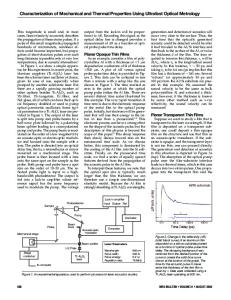Mechanical and Thermal Properties of Graphene Nanomeshes
- PDF / 14,942,939 Bytes
- 6 Pages / 612 x 792 pts (letter) Page_size
- 49 Downloads / 459 Views
Mechanical and Thermal Properties of Graphene Nanomeshes Newton Cunningham Braga Mostério1 and Alexandre F. Fonseca2,3 1 Programa de Pós-graduação em Engenharia Metalúrgica – Escola de Engenharia Industrial e Metalúrgica de Volta Redonda (EEIMVR) – UFF, Av. dos Trabalhadores, 420, Volta Redonda, RJ, 27255-125, Brazil. 2 UNESP – Sao Paulo State University, Department of Physics, Bauru, Sao Paulo, Brazil 3 Instituto de Ciências Exatas – UFF, Rua Desembargador Ellis Hermydio Figueira, 783, Bairro Aterrado, Volta Redonda, RJ, 27213-415, Brazil. ABSTRACT Graphene possesses excellent mechanical, thermal and electronic properties, not to mention its optical transparency and chemical stability. Much effort has been made towards the control of its physical properties for technological applications. One way to achieve this control is by modifying graphene size and structure. Recently, in a search for the development of semiconducting graphene structures to be produced at large scale, a new structure called graphene nanomesh was synthesized by means of block copolymer lithography and other methods. Basically, a graphene nanomesh is a graphene structure made to possess a periodic array of nanoscale holes whose sizes and hole-to-hole (or neck) distances are considered as control parameters for its overall electronic properties. Although the electronic properties of graphene nanomeshes are being intensively studied, their mechanical properties are still to be investigated. This work, then, presents the first study of mechanical, structural and thermal properties of graphene nanomeshes as a function of hole and neck sizes, through atomistic molecular dynamics simulations. The dependence of the Young’s modulus and coefficient of thermal expansion of graphene nanomeshes on the hole and neck sizes will be shown. INTRODUCTION Graphene is a single atomic thick bidimensional structure made entirely of carbon atoms with sp2 type bonds forming a hexagonal network. Isolated graphene was not believed to be observed because planar crystals should not exist in free form due to thermodynamic instabilities [1]. However, Geim, Novoselov and collaborators, in 2004 [2,3], managed to isolate single layers of graphene by mechanical cleavage, thus giving rise to a new “graphene field” of investigation [4] that has attracted much attention from all-world scientific and technological research groups. Extremely tough, durable and capable of conducting electrons at room temperature faster than any other material, most of graphene’s properties results from a special combination of strong sp2 and weak π-π chemical bonds [3-5]. One limitation of graphene in applications to nanoelectronics is the fact that it is a gapless semiconductor. It motivated intense research on derivatives of graphene such as graphene nanoribbons [6,7], graphane [8] and graphene oxide [9]. More recently, a new derivative of graphene structure called graphene nanomesh (GN) was recently derived by means of block copolymer lithography [10], use of self-assembled monolayers of monodisper
Data Loading...











